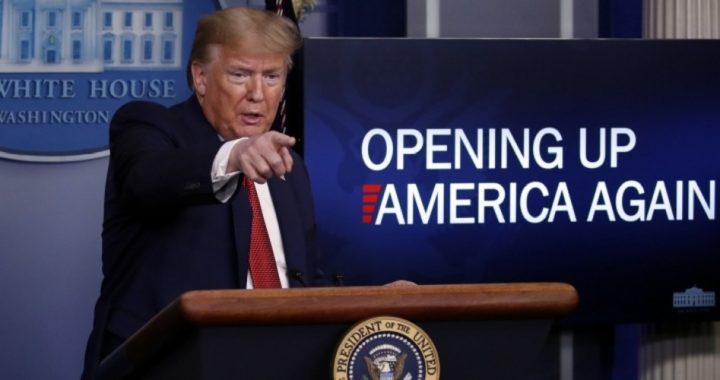
President Donald Trump told a gathering of governors in Washington on Thursday about his plan to reopen the U.S. economy, calling it “Opening up America Again.” He said, “We are not opening all at once but one careful step at a time.” Based on advice from his advisors, it calls for a three-phase, “science-based” strategy that he is recommending to the states.
Phase One calls for governors to announce that sports arenas, restaurants, and movie theaters could open but with social-distancing remaining in place. Under Phase Two, non-essential travel can resume, schools and daycare centers can reopen, and sporting arenas can operate with “moderate” social distancing rules applying.
Phase Three is removal of all restrictions, with businesses bringing back their workers and hospitals and nursing homes allowing visitors once again. The only restrictions remaining would apply to vulnerable individuals, who would continue to be encouraged to practice social-distancing and avoid “crowded environments.”
The administration recommends that each stage be separated by a period of 14 days, during which the number of cases of infection has steadily declined.
Governors of 42 states have implemented some form of social distancing and some of them could reopen immediately. Governors of North Dakota, Ohio, and Tennessee, for example, have begun talking about reopening in two weeks, on May 1. Others are working in tandem, coordinating their own plans for reopening, including seven East Coast states, seven Midwestern states, and three on the West Coast. Among the nine states with the lowest infections — Maine, Vermont, West Virginia, Nebraska, North Dakota, Montana, Wyoming, Alaska, and Hawaii — not all governors are pushing to open immediately. North Dakota, for example, appears to be experiencing an increase in cases, which could put off its opening by another couple of weeks.
None of this makes House Speaker Nancy Pelosi happy. On Tuesday she sent a letter to her Democratic colleagues, calling out the president for mishandling the whole response to the COVID-19/coronavirus threat.
It was all about “the truth,” she claimed:
To succeed in this crisis, we must insist on the truth, and we must act upon it!
In order to move forward, we must first understand the truth of what has put us in this position:
The truth is that Donald Trump dismantled the infrastructure handed to him which was meant to plan for and overcome a pandemic, resulting in unnecessary deaths and economic disaster.
The truth is that in January Donald Trump was warned about this pandemic, ignored those warnings, took insufficient action and caused unnecessary death and disaster.
The truth is that Donald Trump told his most loyal followers that the pandemic was a hoax and that it would magically disappear, thus endangering lives and paving the way for economic disaster.
The truth is that we did not have proper testing available in March despite Trump repeatedly claiming that we did; and even now, we do not have adequate tests, masks, PPE, and necessary equipment, which creates unnecessary death and suffering.
The truth is because of an incompetent reaction to this health crisis, the strong economy handed to Donald Trump is now a disaster, causing the suffering of countless Americans and endangering lives.
The truth is a weak person, a poor leader, takes no responsibility. A weak person blames others.
The president couldn’t resist the temptation to respond in kind, tweeting on Thursday: “Crazy Nancy Pelosi, you are a weak person. You are a poor leader. You are the reason America hates career politicians, like yourself.”
No matter how the reopening rolls out, the main question remains: What will the economy look like? And how soon?
Professor of Economics Antonia Fatas at INSEAD — the “business school for the world” — gave an optimistic appraisal on Friday based upon his home country of Spain. In the school’s blog, he wrote that, in Spain, “Every year industrial production stops for the month of August. The factories close and activity is reduced by 30 percent. But then, towards the end of the month, when people return from holiday, everything gets back into gear, people go back to work and production returns to normal.”
That’s not likely to happen across the United States. Instead, the economy is more likely to look like the front yard of a suburban home, where fertilizer was applied haphazardly: There will be thriving areas that need cutting on a weekly basis while others will need long periods of watering and reseeding to get them to look as nice.
But by the end of the summer — goes this analogy — the entire front yard will look beautiful, just as nice as it did last year, if not nicer.
Photo: AP Images
An Ivy League graduate and former investment advisor, Bob is a regular contributor to The New American, writing primarily on economics and politics. He can be reached at [email protected].




